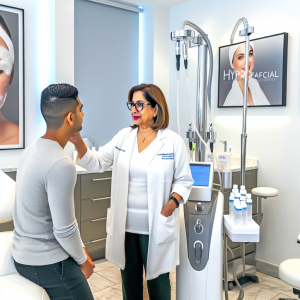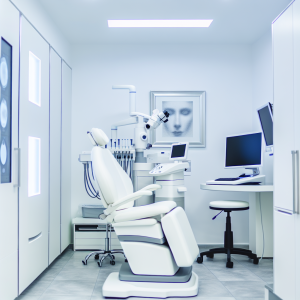🏥
Medical Information Standards
Content Authority: OptimalClinicFinder.com is a comprehensive medical directory platform connecting patients with qualified Prp Hair Restoration providers. Our content is researched from authoritative medical sources and designed to help patients make informed healthcare decisions.
How PRP Hair Restoration Works: Clinical Mechanism and Biological Pathways
Platelet-Rich Plasma therapy harnesses the body’s natural healing mechanisms by concentrating growth factors and cytokines found in platelets. When blood is drawn and processed through specialized centrifugation, platelets are separated and concentrated to levels 3-5 times higher than normal blood. These concentrated platelets contain over 30 bioactive proteins, including platelet-derived growth factor (PDGF), vascular endothelial growth factor (VEGF), and insulin-like growth factor (IGF-1).
The injection of concentrated PRP into the scalp activates dormant hair follicles through multiple biological pathways. Growth factors stimulate angiogenesis, creating new blood vessels that improve nutrient delivery to hair follicles. Simultaneously, stem cell activation occurs in the hair follicle bulge region, promoting the transition from telogen (resting) to anagen (growth) phase. This process also increases hair shaft diameter and extends the anagen phase duration, resulting in thicker, stronger hair growth.
💡
Did You Know?
Clinical studies show that Prp Hair Restoration patients achieve excellent results when combined with professional-grade aftercare products.
Clinical Research and Evidence Base for Plasma Therapy for Hair
The clinical evidence supporting plasma therapy for hair continues to expand through rigorous scientific research. A landmark 2023 systematic review analyzing 15 randomized controlled trials found that PRP therapy increased hair density by an average of 31.3 hairs per square centimeter compared to control groups. The RESTORE-1 and RESTORE-2 trials, involving 421 participants, demonstrated sustained hair count improvements of 18-22% at 26-week follow-up periods.
Comparative effectiveness studies have shown PRP therapy performs favorably against traditional treatments. When compared to topical minoxidil, PRP demonstrated superior outcomes in hair count, thickness, and patient satisfaction scores. Subgroup analyses revealed particular effectiveness in patients with androgenetic alopecia grades I-IV on the Norwood-Hamilton scale, with response rates reaching 85% in early-stage hair loss cases. Long-term follow-up studies extending to 2 years confirm durability of benefits with appropriate maintenance protocols.
Treatment Protocols and Clinical Management
Successful PRP hair restoration requires standardized protocols and individualized treatment planning. The initial consultation includes comprehensive hair loss assessment using dermoscopy, pull tests, and standardized photography. Laboratory screening evaluates platelet count, hemoglobin levels, and markers for bleeding disorders or infections that could contraindicate treatment.
The standard treatment protocol involves a series of 3-4 sessions spaced 4-6 weeks apart, followed by maintenance treatments every 6-12 months. Each session begins with blood collection of 20-60ml, depending on treatment area size. The blood undergoes dual-spin centrifugation to achieve optimal platelet concentration while minimizing red blood cell contamination. Local anesthesia is administered before injection of PRP at 1cm intervals across affected scalp areas using 30-gauge needles at appropriate depths of 4-5mm to reach hair follicle stem cell niches.
💡
Quick Tip
Prp Hair Restoration works best when combined with healthy lifestyle choices for optimal results.
Patient Selection Criteria and Outcome Predictors
Optimal patient selection is crucial for maximizing PRP therapy success rates. Ideal candidates include patients with androgenetic alopecia in early to moderate stages, with evidence of miniaturized but viable hair follicles. Dermoscopic examination revealing yellow dots, short vellus hairs, and maintained follicular openings indicates good treatment potential. Patients with recent-onset alopecia areata also demonstrate excellent response rates, particularly when treatment begins within 6 months of hair loss onset.
Factors that may limit treatment effectiveness include advanced hair loss with complete follicular atrophy, scarring alopecia conditions, and certain medical comorbidities. Age considerations show that patients between 18-60 years generally achieve optimal results, though individual health status is more predictive than chronological age. Lifestyle factors including smoking, nutritional deficiencies, and hormonal imbalances should be addressed concurrently to optimize treatment outcomes.
Safety Profile and Adverse Event Management
PRP hair restoration demonstrates an excellent safety profile due to its autologous nature, using the patient’s own blood components. Clinical trials report adverse event rates below 3%, with most reactions being mild and transient. Common side effects include temporary scalp tenderness, minor swelling, and occasional bruising at injection sites, typically resolving within 24-48 hours.
Serious adverse events are extremely rare but can include infection if sterile protocols are not followed, nerve injury from improper injection technique, or allergic reactions to anesthetic agents. Risk mitigation strategies include strict adherence to sterile processing protocols, proper provider training, and comprehensive patient screening. Contraindications include active scalp infections, bleeding disorders, platelet dysfunction syndromes, and certain autoimmune conditions that may be exacerbated by growth factor stimulation.
Cost Analysis and Insurance Considerations
The cost structure for PRP hair restoration varies significantly based on geographic location, provider expertise, and treatment complexity. Individual session costs typically range from $1,200-$4,500, with most patients requiring initial treatment series of 3-4 sessions. Total initial treatment costs generally range from $4,000-$15,000, followed by annual maintenance costs of $1,500-$3,000.
✓
Why Choose Prp Hair Restoration?
●
Clinically proven
●
FDA approved
●
Minimal downtime
●
Long-lasting
Insurance coverage for PRP hair therapy remains limited, as most carriers classify hair restoration as cosmetic treatment. However, coverage may be available for certain medical conditions causing hair loss, such as alopecia areata or chemotherapy-induced alopecia. Patient financing options include medical credit lines, payment plans offered by practices, and health savings account utilization. When evaluating costs, patients should consider the treatment’s durability, safety profile, and potential to delay or eliminate need for surgical hair restoration procedures.
Provider Selection and Treatment Quality Assurance
Selecting a qualified provider is essential for safe, effective PRP hair restoration. Board certification in dermatology, plastic surgery, or other relevant medical specialties provides foundational training, but specific experience with PRP protocols and hair restoration is crucial. Providers should demonstrate proficiency in sterile blood processing techniques, proper injection methods, and comprehensive patient evaluation protocols.
Quality indicators include use of FDA-approved PRP processing systems, adherence to sterile protocols, standardized outcome measurement tools, and transparent communication about realistic expectations. Patients should verify provider credentials, review before-and-after photographs of actual patients, and understand the complete treatment protocol including maintenance requirements. Avoiding non-medical providers or facilities offering unusually low prices helps ensure treatment safety and effectiveness.
📚 Medical Authorities & Professional Standards
All Prp Hair Restoration procedures should be performed by licensed medical professionals following established clinical guidelines and safety protocols.
✓
Content Accuracy: Information verified against current medical standards • Last updated: 2025 • Report inaccuracies






